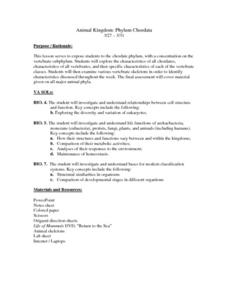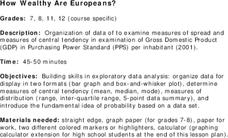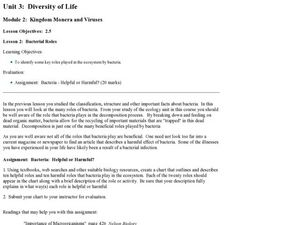Curated OER
Microorganism Multiplication
Sixth graders conduct experiments with yeast to study characteristics of microorganisms. They, working is small groups, change the variables in the experiments and note the results which they later discuss as a class.
Curated OER
Penguins: Sensitive Indicators
Students examine how penguins are affected by climate change. In this climate change lesson students research the impact of climate change then create a poster to call awareness to it.
Curated OER
Investigating Animals in Water
Students observe small animal activity. They identify local water animals and describe the habitats where water animals can be found. Students collect samples to observe in the classroom.
Curated OER
Honey Bee Biology
Students review the basic parts of an insect and explore the anatomical characteristics of a honey bee. The second part of the lesson focuses on ways to identify a honey bee from other stinging insects.
Curated OER
Birth, Growth and... Reproduction!
Students research the Arctic Hare and chart relevant information under month headings. They compare the information about the Arctic hare to other Arctic mammals.
Curated OER
Presidential Briefing
In this comparative government worksheet, students follow the steps provided to form a National Security Council and then brief the President on long-term goals for the nation. Students prepare written briefs with charts and graphics...
Curated OER
Exploring the Objectives of the European Union
Students identify the members of the EU and brainstorm on how these countries would benefit by having an alliance. In groups, they examine the main objectives of the EU and present to the class.
Curated OER
Algal Blooms
In this algal blooms worksheet, students order the stages of a red tide. They answer two short answer questions. Students define three terms relating to algal blooms.
Curated OER
Feudalism
Students have tournaments in teams after learning information about The Middle Ages. In this Middle Ages lesson plan, students learn that tournaments are mock battles, but that they will have these battles by answering questions in teams...
Curated OER
Protist Crossword
In this protist activity, students complete a crossword puzzle with 34 questions about the behaviour and different types of protists.
Curated OER
Animal Kingdom: Phylum Chordata
Learners use a dichotomous key to classify various vertebrate jar speciments into classes. They examine the speciments for general characteristics of each class and fill in a corresponding chart and then complete a few final assessment...
Curated OER
Invertebrate Classification
High schoolers discuss the recent disovery of the "furry lobster" to peak interest in the animal kingdom. They classify various speciments using invertebrate dichotomous keys, identifying major animal phyla and classes. Thy the complete...
Curated OER
How Wealthy Are Europeans?
Students investigate measures of central tendency. They examine compiled data and conduct critical analysis. The graph is focusing on the gross domestic product data. The lesson also reviews the concept of putting values in order of...
Curated OER
Bacterial Roles
Students study bacteria and the role it plays in the ecosystem. In this bacteria instructional activity students research the roles bacteria has and submit a chart.
Other
Panhandle Area Educational Consortium: The Six Kingdoms of Life [Pdf]
Scientists look at the evolutionary history of organisms to divide them into kingdoms. For awhile, there has been 5 kingdoms, but many scientist are now using 6 kingdoms.
Other
Alternative Classifications of Life
The Linnaean system (1758) classified all macroscopic living organisms as either Animals or Plants, based on whether they moved [anima, with a soul] or not. Thus, Fungi were included as plants. With the invention of the microscope and...
BiologyWise
Biology Wise: Types of Protists
Explains what types of organisms are in the kingdom Protista and describes the different types of protists in five broad categories and in their sub-categories.
















![Panhandle Area Educational Consortium: The Six Kingdoms of Life [Pdf] Handout Panhandle Area Educational Consortium: The Six Kingdoms of Life [Pdf] Handout](https://d15y2dacu3jp90.cloudfront.net/images/attachment_defaults/resource/large/FPO-knovation.png)
